Bacterial Cell StructureBacteria are not connected to humans as living creatures, yet they are necessary for human existence and life on the planet. Despite their reputation for bringing human ailments ranging from tooth decay to the black plague, certain species are considered helpful for one's health. 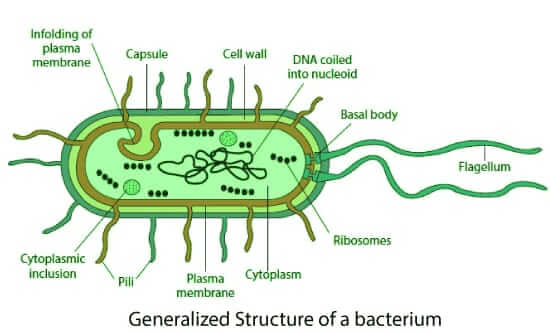
One symbiotic species in the large intestine, for example, produces vitamin K, an important blood-clotting component. Other species provide indirect benefits. Bacteria are responsible for the tangy flavor of yogurt and the sour taste of sourdough bread. Ruminant animals (cows, sheep, and goats) can digest plant cellulose and certain plants (soybeans, peas, and alfalfa) and can even convert nitrogen to a more useful form. Bacteria are prokaryotes with chromosomes made up of a single closed DNA circle and no well-defined nuclei or membrane-bound organelles. Bacterial cells are present in spheres, cylinders, spirals, and rods. They can be filamentous or non-filamentous. They may be found almost everywhere on the planet and live in some of the most strange and harsh environments. One of the oldest species ever existed on this planet is bacteria. A different classification of bacteria called archaebacteria thrives in varied harsh environments like high salinity, boiling water, acidity, alkalinity, and even deep below the arctic ice. It is assumed that both the archaea and bacteria have diverged from a common ancestor. Also, it has been found by various researchers that even eukaryotes have separated from archaea millions of years ago. Despite their apparent similarity to bacteria, the archaea are biochemically and genetically not like bacteria as bacteria are to humans. Antoni van Leeuwenhoek was the first to examine microorganisms under a microscope in the late 1600s. During the 19th century, French scientist Louis Pasteur showed the importance of bacteria as pathogens in his research work, along with another scientist, Robert Koch, a German Physician. Numerous advancements in bacteriology occurred throughout the twentieth century, demonstrating their variety, ancient ancestry, and overall relevance. Most notably, several scientists from throughout the globe contributed to the area of microbial ecology, demonstrating the importance of bacteria in food webs and the general health of Earth's ecosystems. Antibiotics were developed when scientists discovered that certain bacteria generated substances that killed other germs. This discovery transformed medicine. There are two methods for classifying bacteria. 1. The first method is to classify them depending on how the bacteria react to different oxygen environments. So, on the basis of oxygen, they have been classified into three broad categories.
2. The second approach to categorizing them is based on how they get their energy.
Components of Bacterial CellFollowing are the components of Bacterial cell CapsuleSome bacteria species have a third protective shell, a polysaccharide capsule (complex carbohydrates). This is where the capsule functions. They protect bacteria from drying out and from engulfment (phagocytosis) by bigger organisms. Bacteria are prone to phagocytosis and cell death. The capsule is a crucial virulence component in bacteria that cause illness, such as E. coli and Streptococcus pneumonia. These organisms' nonencapsulated mutations are avirulent, meaning they don't cause illness. Cell envelopeIt is divided into three distinct parts, viz, outer cell wall, inner cytoplasmic membrane, and in some bacteria outside the cell wall, there is another layer called a capsule. Cell wallA stiff cell wall comprising peptidoglycan, a protein-sugar (polysaccharide) polymer, surrounds each bacterium. The cytoplasmic membrane is surrounded by the wall, which gives the cell its structure and protects it from the environment. When there are differences in the environment, like osmotic differences, the cell wall helps the cell maintain its shape and prevents it from bursting. Bacteria have pili and flagella, which are structures for anchoring. The cell wall also aids in anchoring these structures as they protrude from the cytoplasm. 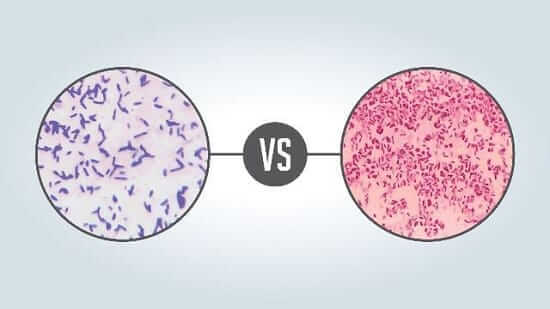
The composition of bacteria's cell walls varies greatly, and it is one of the essential aspects of bacterial species identification and differentiation. For example, a rather thick, mesh-like structure allows two fundamental bacteria species to be distinguished. To differentiate between two types of bacterial cells, a physicist, a Danish scientist, Hans Christian Gram, developed a staining technique called gram staining. Gram-positive bacteria on staining give purplish color. On the other hand, gram-negative bacteria stains pinkish. This is because gram-positive bacterial cells retain the purple dye upon washing with alcohol, whereas the gram-negative cell wall does not. CytoplasmThe cytoplasm, or protoplasm, is where cell development, metabolism, and reproduction occur in bacterial cells. All the cell components are enclosed within a gel-like matrix of the cell. It contains chromosomes, ribosomes, plasmids, water, waste, gases, and different nutrients. The cytoplasm and all of its components are encased in the cell envelope. Bacteria, unlike eukaryotic (true) cells, lack a membrane-enclosed nucleus. Bacteria is a prokaryotic cell. It does not have a well-defined nucleus. But instead, it has a loosely defined nucleoid where the cell's chromosome as one continuous strand of DNA is present. The rest of the cellular components are strewn around in the cytoplasm. 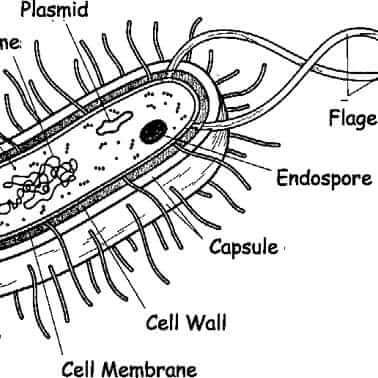
In addition to a single chromosome, Bacterial cells also contain multiple plasmids. These are small circular extrachromosomal genetic structures present in almost all bacterial cells. Plasmids, like chromosomes, are made up of a circular segment of DNA. They are not engaged in reproduction, unlike the chromosome. Plasmids replicate independently of the chromosome and provide bacteria with a selection advantage, even though they are not required for life. The chromosome of the bacterial cells code all the information required for carrying out fundamental processes like binary fission, cell division, reproduction, etc. There are two ways bacteria can transfer their plasmid into other bacterial cells. During the process of binary fission, plasmid copies from the cytoplasm are passed on to the daughter cells. The second method is through the formation of pilus. Pilus is a tube-like structure on the surface of bacterial cells, and transfer takes place by conjugation. Conjugation is the process of the transfer of genetic information between two bacterial cells. Plasmids have been demonstrated to have a role in transferring unique characteristics such as antibiotic treatment resistance, heavy metal resistance, and virulence factors required for infection of animal or plant hosts. Plasmids have become incredibly helpful tools in molecular biology and genetics, particularly in the field of genetic engineering, because of their capacity to insert specific genes into them. Cytoplasmic MembraneAll the material is transported in and out of the cell selectively due to a cytoplasmic membrane. It is a semi-permeable membrane that directs the entry and exit of molecules. It comprises a layer of phospholipids, and proteins are embedded in it. All living cells possess this selectively permeable membrane to direct the movement of molecules in and out of the cells. Membranes are asymmetric and highly structured, with two sides, each with a distinct surface and purpose. Membranes are likewise dynamic, responding to changing environments regularly. Flagella (singular: flagellum)The movement of bacteria is possible because of a hairlike structure called flagella. They may be found inside or outside a bacterium and all over its surface. The movement of flagella occurs in a propeller-like motion, and by doing, it assists the movement of the bacterial cell toward different stimuli like food, light, water, etc. 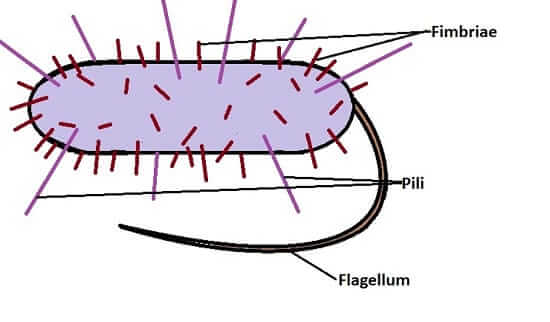
NucleoidProkaryotic organism, unlike eukaryotic organism, does not have a defined nucleus. Instead, they have a dense region in the cytoplasmic area called the nucleoid. Nucleoid is the region where a single chromosomal DNA of bacteria is present, not a membrane-bound organelle. 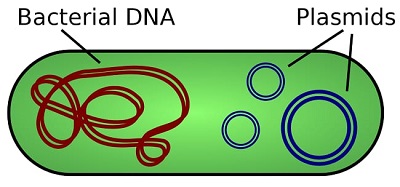
Although a few species have two or more, most bacteria have a single circular chromosome responsible for replication. Plasmids, smaller circular auxiliary DNA strands, are also seen in the cytoplasm. Pili (singular, pilus)They are tiny hairlike projections that emerge from the outer cell membrane of many bacterium species. The bacteria use these outgrowths to connect to other cells and surfaces, such as teeth, intestines, and rocks. Many disease-causing bacteria lose their capacity to infect because they can't connect to host tissue without pili. Conjugation occurs when two bacteria exchange plasmid DNA pieces through specialized pili. RibosomesThese are small "factories" that may be found in all organisms, including bacteria. They convert the genetic information from nucleic acid's chemical language to amino acids, which are the building blocks of proteins. Proteins are the molecules that allow cells and living beings to conduct all of their activities. Ribosomes are present in both eukaryotes and prokaryotes. However, eukaryotic ribosomes are distinct from prokaryotic. Bacterial ribosomes (prokaryotic) are smaller and have slightly different molecular compositions and structures. Eukaryotic ribosomes are attached to other organelles, whereas bacterial ribosomes are free to spread throughout the cytoplasm. Since there are enough distinctions between bacterial and eukaryotic ribosomes, certain antibiotics will block bacterial ribosome function but not eukaryotic ribosome function, killing bacteria but not eukaryotic organisms.
Next TopicAnaerobic Bacteria
|
 For Videos Join Our Youtube Channel: Join Now
For Videos Join Our Youtube Channel: Join Now
Feedback
- Send your Feedback to [email protected]
Help Others, Please Share









